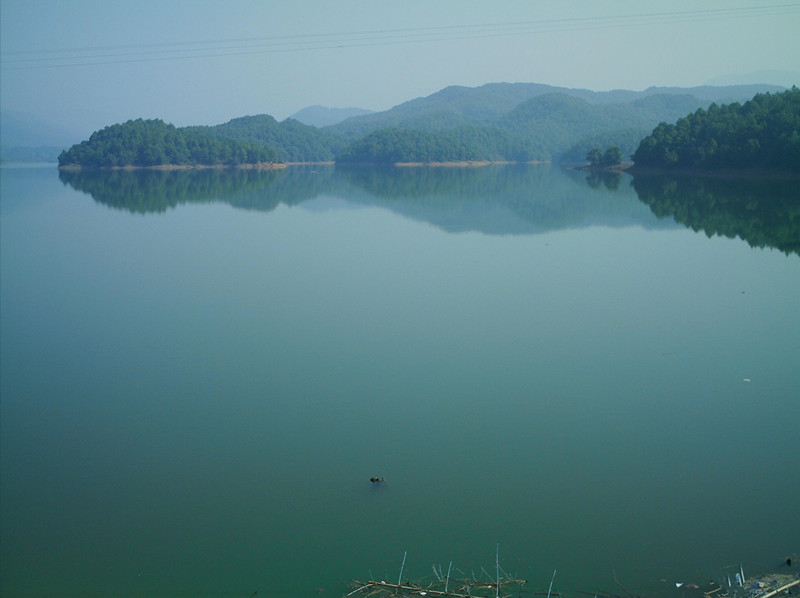
Jinggu River Reservior in Jinggu County, Puer
Overview of Leiguang Temple
Leiguang Temple (雷光佛迹寺, Daxianrenjiao Temple) is located in Yongping Town, Jinggu County (景谷县, Jinggu Xian), Puer City (普洱市, Puer Shi). Often referred to by locals as “Daxianrenjiao Temple,” it was established in the 50th year of the Qianlong reign (乾隆, Qianlong) of the Qing Dynasty (清朝, Qing Chao). This temple is a significant site for Theravada Buddhism, housing four large footprints believed to have been left by the Buddha during his ascent to heaven.
As I approached the entrance of Leiguang Temple, a stone archway came into view. Although modest in size, it exudes a sense of antiquity. There are no walls around the archway, and two open gates enhance its spacious feel. A large character “佛” (Buddha) is carved prominently on the central stone tablet, symbolizing entry into the sacred realm of Buddhism, suggesting a passage into the “empty gate.”
Notable Features and Legends
Climbing the steps, I turned to see a couplet inscribed in Chinese on the back of the stone archway:
- Upper Couplet: “It is not a trivial hardship; where can one seek the immortal’s traces?”
- Lower Couplet: “If not for countless strategies, how could such famous mountains exist here?”
The inscription reflects the artistic skill of ancient literati. The central inscription records the person responsible for the monument and the date: “In the 50th year of Qianlong, under the stewardship of Hu Chao, it was established in the month of Mengchun.”
The archway is divided into two parts. On the left, inscriptions recount the process of the Buddha leaving his footprints here, while the other details the construction of the temple.
Upon respectfully removing my shoes and entering the main hall, I was greeted by the serene visage of the Buddha seated on a lotus platform, embodying compassion and a broad heart for saving and helping all beings. At the foot of the giant Buddha, a massive stone bears four overlapping footprints, each representing different saints who ascended to heaven after extensive periods of meditation.
- The first footprint belongs to Gage Shengta, who meditated for 40,000 years.
- The second belongs to Gena Ga Mana, meditating for 30,000 years.
- The third belongs to Gasaiba, meditating for 20,000 years.
- The fourth belongs to Guo Dama, identified as Siddhartha Gautama (释迦牟尼, Shijia Mouni).
Legend has it that Siddhartha Gautama, upon his birth, was able to walk and left a lotus flower with each step. His ascension occurred around 470 BCE, during which he left a peacock and a golden rooster at the footprints’ sides, waiting for the fifth Buddha’s arrival.
Water Well and Blessings
Below the giant footprints lies a small well that never runs dry, regardless of the season. This well is considered holy water, believed to cure ailments. Visitors often take a bottle of this water home as a blessing.
Our host warmly explained various artifacts and paintings within the temple, enriching our understanding of Leiguang Temple’s history. The site has deep cultural significance, as it has been a place of spiritual pilgrimage for centuries.
Natural Resources and Water Management
Jinggu River Reservoir
The Jinggu River Reservoir (景谷河水库, Jinggu He Shuiku) is situated upstream on the Jinggu River in Jinggu County. Construction began in September 1983 and was completed in May 1990. The reservoir has a total capacity of 56.7 million cubic meters and serves multiple purposes: irrigation, flood control, power generation, industrial water supply, and urban drinking water supply.
Historically, water has been a lifeblood for civilizations, influencing the development of societies near great rivers such as the Yellow River (黄河, Huang He) and the Nile River (尼罗河, Ni Luo He). In Jinggu County, water resources are abundant, with 94 rivers and a total water resource volume of 6.72 billion cubic meters, averaging 23,500 cubic meters per person.
Despite these resources, the region has faced challenges such as droughts and floods due to complex topography and heavy rains concentrated in July and August. Historical mismanagement and deforestation have led to soil erosion, affecting water supply stability for many communities.
Conclusion
Leiguang Temple and Jinggu River Reservoir are vital cultural and natural landmarks in Jinggu County, embodying both spiritual significance and resource management challenges.
How to Get There
To reach Leiguang Temple, you can fly into Puer Airport (普洱机场, Puer Jichang) and take a taxi or local bus to Jinggu County. The temple is about 30 km from the county center. For the Jinggu River Reservoir, follow the main road from Jinggu County for approximately 20 km.
Travel Tips
- Dress Respectfully: When visiting temples, ensure to dress modestly.
- Bring Water: Stay hydrated, especially during warmer months.
- Respect Local Customs: Engage respectfully with local traditions and practices.
- Timing: Visit early in the morning or late afternoon for fewer crowds and cooler temperatures.



 7 Days GolfingTour
7 Days GolfingTour
 8 Days Group Tour
8 Days Group Tour
 8 Days Yunnan Tour
8 Days Yunnan Tour
 7 Days Shangri La Hiking
7 Days Shangri La Hiking
 11 Days Yunnan Tour
11 Days Yunnan Tour
 6 Days Yuanyang Terraces
6 Days Yuanyang Terraces
 11 Days Yunnan Tour
11 Days Yunnan Tour
 8 Days South Yunnan
8 Days South Yunnan
 7 Days Tea Tour
7 Days Tea Tour
 8 Days Muslim Tour
8 Days Muslim Tour
 12 Days Self-Driving
12 Days Self-Driving
 4 Days Haba Climbing
4 Days Haba Climbing
 Tiger Leaping Gorge
Tiger Leaping Gorge
 Stone Forest
Stone Forest
 Yunnan-Tibet
Yunnan-Tibet
 Hani Rice Terraces
Hani Rice Terraces
 Kunming
Kunming
 Lijiang
Lijiang
 Shangri-la
Shangri-la
 Dali
Dali
 XishuangBanna
XishuangBanna
 Honghe
Honghe
 Kunming
Kunming
 Lijiang
Lijiang
 Shangri-la
Shangri-la
 Yuanyang Rice Terraces
Yuanyang Rice Terraces
 Nujiang
Nujiang
 XishuangBanna
XishuangBanna
 Spring City Golf
Spring City Golf
 Snow Mountain Golf
Snow Mountain Golf
 Stone Mountain Golf
Stone Mountain Golf
















